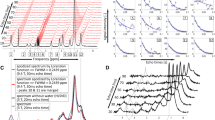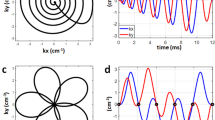Abstract
Objectives
Our aim was to demonstrate the benefits of using locally low-rank (LLR) regularization for the compressed sensing reconstruction of highly-accelerated quantitative water-fat MRI, and to validate fat fraction (FF) and \({R_2^*}\) relaxation against reference parallel imaging in the abdomen.
Materials and methods
Reconstructions using spatial sparsity regularization (SSR) were compared to reconstructions with LLR and the combination of both (LLR+SSR) for up to seven fold accelerated 3-D bipolar multi-echo GRE imaging. For ten volunteers, the agreement with the reference was assessed in FF and \({R_2^*}\) maps.
Results
LLR regularization showed superior noise and artifact suppression compared to reconstructions using SSR. Remaining residual artifacts were further reduced in combination with SSR. Correlation with the reference was excellent for FF with \(R^2\) = 0.99 (all methods) and good for \({R_2^*}\) with \(R^2\) = [0.93, 0.96, 0.95] for SSR, LLR and LLR+SSR. The linear regression gave slope and bias (%) of (0.99, 0.50), (1.01, 0.19) and (1.01, 0.10), and the hepatic FF/\({R_2^*}\) standard deviation was 3.5%/12.1 s\(^{-1}\), 1.9%/6.4 s\(^{-1}\) and 1.8%/6.3 s\(^{-1}\) for SSR, LLR and LLR+SSR, indicating the least bias and highest SNR for LLR+SSR.
Conclusion
A novel reconstruction using both spatial and spectral regularization allows obtaining accurate FF and \({R_2^*}\) maps for prospectively highly accelerated acquisitions.








Similar content being viewed by others
Notes
As a measure of image noise, SNR is defined as the average signal over the standard deviation in a homogeneous region of interest. Traditionally, higher SNR meant improved image quality. In the light of non-linear algorithms such as CS, it alone cannot serve as universal measure of image quality because reduced noise can simply be induced by reducing image resolution.
References
Meisamy S, Hines CD, Hamilton G, Sirlin CB, McKenzie CA, Yu H, Brittain JH, Reeder SB (2011) Quantification of hepatic steatosis with T1-independent, T2*-corrected MR imaging with spectral modeling of fat: blinded comparison with MR spectroscopy. Radiology 258(3):767–775
Bashir MR, Zhong X, Nickel MD, Fananapazir G, Kannengiesser SA, Kiefer B, Dale BM (2015) Quantification of hepatic steatosis with a multistep adaptive fitting MRI approach: prospective validation against MR spectroscopy. Am J Roentgenol 204(2):297–306
Dixon WT (1984) Simple proton spectroscopic imaging. Radiology 153(1):189–194
Reeder SB, Cruite I, Hamilton G, Sirlin CB (2011) Quantitative assessment of liver fat with magnetic resonance imaging and spectroscopy. J Magn Reson Imaging 34(4):729–749
Reeder SB, Pineda AR, Wen Z, Shimakawa A, Yu H, Brittain JH, Gold GE, Beaulieu CH, Pelc NJ (2005) Iterative decomposition of water and fat with echo asymmetry and least-squares estimation (IDEAL): application with fast spin-echo imaging. Magn Reson Med 54(3):636–644
Koken P, Eggers H, Börnert P (2007) Fast single breath-hold 3D abdominal imaging with water-fat separation. In: Proceedings of the 15th scientific meeting, international society for magnetic resonance in medicine, Berlin, pp 1623
Liu CY, McKenzie CA, Yu H, Brittain JH, Reeder SB (2007) Fat quantification with IDEAL gradient echo imaging: correction of bias from T1 and noise. Magn Reson Med 58(2):354–364
Bydder M, Yokoo T, Hamilton G, Middleton MS, Chavez AD, Schwimmer JB, Lavine JE, Sirlin CB (2008) Relaxation effects in the quantification of fat using gradient echo imaging. Magn Reson Imaging 26(3):347–359
Yu H, Shimakawa A, McKenzie CA, Brodsky E, Brittain JH, Reeder SB (2008) Multiecho water-fat separation and simultaneous R2* estimation with multifrequency fat spectrum modeling. Magn Reson Med 60(5):1122–1134
Lustig M, Donoho D, Pauly JM (2007) Sparse MRI: the application of compressed sensing for rapid MR imaging. Magn Reson Med 58(6):1182–1195
Doneva M, Börnert P, Eggers H, Mertins A, Pauly J, Lustig M (2010) Compressed sensing for chemical shift-based water-fat separation. Magn Reson Med 64(6):1749–1759
Sharma SD, Hu HH, Nayak KS (2013) Accelerated T2*-compensated fat fraction quantification using a joint parallel imaging and compressed sensing framework. J Magn Reson Imaging 38(5):1267–1275
Wiens CN, McCurdy CM, Willig-Onwuachi JD, McKenzie CA (2014) R2*-corrected water-fat imaging using compressed sensing and parallel imaging. Magn Reson Med 71(2):608–616
Sharma SD, Trzasko JD, Manduca A (2013) Calibrationless chemical shift encoded imaging using a time-segmented k-space reconstruction. In: Proceedings of the 21st scientific meeting, international society for magnetic resonance in medicine, Salt Lake City, pp 130
Soliman AS, Wiens CN, Wade TP, McKenzie CA (2015) Fat quantification using an interleaved bipolar acquisition. Magn Reson Med 75(5):2000–2008
Mann LW, Higgins DM, Peters CN, Cassidy S, Hodson KK, Coombs A, Taylor R, Hollingsworth KG (2016) Accelerating MR imaging liver steatosis measurement using combined compressed sensing and parallel imaging: a quantitative evaluation. Radiology 278(1):247–256
Hollingsworth KG, Higgins DM, McCallum M, Ward L, Coombs A, Straub V (2014) Investigating the quantitative fidelity of prospectively undersampled chemical shift imaging in muscular dystrophy with compressed sensing and parallel imaging reconstruction. Magn Reson Med 72(6):1610–1619
Bydder M, Du J (2006) Noise reduction in multiple-echo data sets using singular value decomposition. Magn Reson Imaging 24(7):849–856
Lugauer F, Nickel D, Wetzl J, Kannengiesser SA, Maier A, Hornegger J (2015) Robust spectral denoising for water-fat separation in magnetic resonance imaging. In: Medical image computing and computer-assisted intervention—MICCAI 2015, Munich, pp 667–674
Lugauer F, Nickel D, Kannengiesser S, Barnes S, Holshouser B, Wetzl J, Hornegger J, Maier A (2016) Improving parameter map** in MRI relaxometry and multi-echo dixon using an automated spectral denoising. In: Proceedings of the 24th scientific meeting, international society for magnetic resonance in medicine, Singapore, pp 3269
Allen BC, Lugauer F, Nickel D, Bhatti L, Dafalla R, Dale BM, Jaffe T, Bashir M (2016) Effect of a low-rank denoising algorithm on quantitative MRI-based measures of liver fat and iron. In: Proceedings of the 24th scientific meeting, international society for magnetic resonance in medicine, Singapore, pp 4224 (Accepted for publication in JCAT)
Trzasko J, Manduca A, Borisch E (2011) Local versus global low-rank promotion in dynamic MRI series reconstruction. In: Proceedings of the 19th scientific meeting, international society for magnetic resonance in medicine, Montreal, pp 4371
Zhang T, Pauly JM, Levesque IR (2015) Accelerating parameter map** with a locally low rank constraint. Magn Reson Med 73(2):655–661
Lugauer F, Nickel D, Wetzl J, Kiefer B, Hornegger J (2015) Water-fat separation using a locally low-rank enforcing reconstruction. In: Proceedings of the 23rd scientific meeting, international society for magnetic resonance in medicine, Toronto, pp 3652
Hamilton G, Yokoo T, Bydder M, Cruite I, Schroeder ME, Sirlin CB, Middleton MS (2011) In vivo characterization of the liver fat 1H MR spectrum. NMR Biomed 24(7):784–790
Berglund J, Ahlström H, Johansson L, Kullberg J (2011) Two-point dixon method with flexible echo times. Magn Reson Med 65(4):994–1004
Cui C, Wu X, Newell JD, Jacob M (2015) Fat water decomposition using globally optimal surface estimation (GOOSE) algorithm. Magn Reson Med 73(3):1289–1299
Cai JF, Candès EJ, Shen Z (2010) A singular value thresholding algorithm for matrix completion. SIAM J Optim 20(4):1956–1982
Goldstein T, Osher S (2009) The split Bregman method for L1-regularized problems. SIAM J Imaging Sci 2(2):323–343
Figueiredo MA, Nowak RD (2003) An EM algorithm for wavelet-based image restoration. IEEE Trans Image Process 12(8):906–916
Hutter J, Grimm R, Forman C, Hornegger J, Schmitt P (2015) Highly undersampled peripheral time-of-flight magnetic resonance angiography: optimized data acquisition and iterative image reconstruction. Magn Reson Mater Phy 28(5):437–446
Eckstein J, Bertsekas DP (1992) On the Douglas–Rachford splitting method and the proximal point algorithm for maximal monotone operators. Math Program 55(1–3):293–318
Trzasko JD, Manduca A (2011) Calibrationless parallel MRI using CLEAR. In: 2011 Conference record of the forty fifth asilomar conference on signals. Systems and Computers (ASILOMAR), Pacific Grove, pp 75–79
Bridson R (2007) Fast Poisson disk sampling in arbitrary dimensions. In: ACM SIGGRAPH 2007 Sketches. SIGGRAPH '07. ACM, San Diego. doi:10.1145/1278780.1278807
Song C, Wang P, Makse HA (2008) A phase diagram for jammed matter. Nature 453(7195):629–632
Breuer FA, Blaimer M, Mueller MF, Seiberlich N, Heidemann RM, Griswold MA, Jakob PM (2006) Controlled aliasing in volumetric parallel imaging (2D CAIPIRINHA). Magn Reson Med 55(3):549–556
Zhu C, Byrd RH, Lu P, Nocedal J (1997) Algorithm 778: L-BFGS-B: Fortran subroutines for large-scale bound-constrained optimization. ACM Trans Math Softw 23(4):550–560
Zhong X, Nickel MD, Kannengiesser SA, Dale BM, Kiefer B, Bashir MR (2014) Liver fat quantification using a multi-step adaptive fitting approach with multi-echo GRE imaging. Magn Reson Med 72(5):1353–1365
Eggers H, Brendel B, Duijndam A, Herigault G (2011) Dual-echo Dixon imaging with flexible choice of echo times. Magn Reson Med 65(1):96–107
Ong F, Lustig M (2016) Beyond low rank + sparse: multiscale low rank matrix decomposition. IEEE J Sel Top Signal Process 10(4):672–687
Boyd S, Parikh N, Chu E, Peleato B, Eckstein J (2011) Distributed optimization and statistical learning via the alternating direction method of multipliers. Found Trends Mach Learn 3(1):1–122
Katkovnik V, Foi A, Egiazarian K, Astola J (2010) From local kernel to nonlocal multiple-model image denoising. Int J Comput Vis 86(1):1–32
Shea SM, Kroeker RM, Deshpande V, Laub G, Zheng J, Finn JP, Li D (2001) Coronary artery imaging: 3D segmented k-space data acquisition with multiple breath-holds and real-time slab following. J Magn Reson Imaging 13(2):301–307
Taubmann O, Wetzl J, Lauritsch G, Maier A, Hornegger J (2015) Sharp as a Tack. Bildverarbeitung für die Medizin 2015. Springer, Berlin, pp 425–430
Hansen PC (1992) Analysis of discrete ill-posed problems by means of the L-curve. SIAM Rev 34(4):561–580
Artz NS, Haufe WM, Hooker CA, Hamilton G, Wolfson T, Campos GM, Gamst AC, Schwimmer JB, Sirlin CB, Reeder SB (2015) Reproducibility of MR-based liver fat quantification across field strength: same-day comparison between 1.5 T and 3T in obese subjects. J Magn Reson Imaging 42(3):811–817
Lingala SG, Hu Y, DiBella E, Jacob M (2011) Accelerated dynamic MRI exploiting sparsity and low-rank structure: kt SLR. IEEE Trans Med Imaging 30(5):1042–1054
Acknowledgements
This work was partly supported by the Research Training Group 1773 “Heterogeneous Image Systems”, funded by the German Research Foundation (DFG). Author contribution statement Lugauer: Protocol and project development, data collection and analysis. Nickel: Protocol and project development, data management. Wetzl: Data collection and management. Kiefer: Project development. Hornegger: Project development. Maier: Project development
Author information
Authors and Affiliations
Corresponding author
Ethics declarations
Informed consent
This manuscript does not contain clinical studies or patient data. Informed consent was obtained from all volunteers included in the study.
Conflict of interest
Felix Lugauer and Jens Wetzl receive project funding from Siemens Healthcare GmbH. Dominik Nickel and Berthold Kiefer are employees of Siemens Healthcare GmbH.
Appendix: Update terms and solutions of proximal operators
Appendix: Update terms and solutions of proximal operators
Update terms of the SB algorithm enforce the coupling with penalty terms:
The proximal operator for the TV formulation is realized via generalized shrinkage as
with
where \((\varvec{a})_+\) performs component-wise \({\text {max}}\left( 0,\varvec{a}_j \right)\), while soft-thresholding of wavelet coefficients is used for DWTs [29]:
The LLR proximal functional can be solved separately in the case of non-overlap** blocks by singular value soft-thresholding and placing the result back with the adjoint operator \(B^{\dagger }\) [28, 33],
Rights and permissions
About this article
Cite this article
Lugauer, F., Nickel, D., Wetzl, J. et al. Accelerating multi-echo water-fat MRI with a joint locally low-rank and spatial sparsity-promoting reconstruction. Magn Reson Mater Phy 30, 189–202 (2017). https://doi.org/10.1007/s10334-016-0595-7
Received:
Revised:
Accepted:
Published:
Issue Date:
DOI: https://doi.org/10.1007/s10334-016-0595-7




